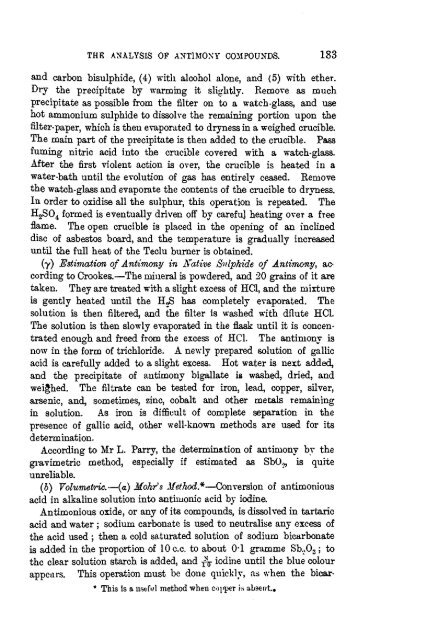antimony - Sciencemadness.org
antimony - Sciencemadness.org
antimony - Sciencemadness.org
Create successful ePaper yourself
Turn your PDF publications into a flip-book with our unique Google optimized e-Paper software.
THE ANALYSIS OF ANTIMONY COMPOUNDS. 183<br />
and carbon bisulphide, (4) with alcohol alone, and (5) with ether.<br />
Dry the precipitate by warming it slightly. Remove as much<br />
precipitate as possible from the niter on to a watch-glass, and use<br />
hot ammonium sulphide to dissolve the remaining portion upon the<br />
filter-paper, which is then evaporated to dryness in a weighed crucible.<br />
The main part of the precipitate is then added to the crucible. Pass<br />
fuming nitric acid into the crucible covered with a watch-glass.<br />
After the first violent action is over, the crucible is heated in a<br />
water-bath until the evolution of gas has entirely ceased. Eemove<br />
the watch-glass and evaporate the contents of the crucible to dryness.<br />
In order to oxidise all the sulphur, this operation is repeated. The<br />
H2SO4 formed is eventually driven off by carefuj heating over a free<br />
flame. The open crucible is placed in the opening of an inclined<br />
disc of asbestos board, and the temperature is gradually increased<br />
until the full heat of the Teclu burner is obtained.<br />
(y) Estimation of Antimony in Native Sulphide of Antimony, according<br />
to Crookes.—The mineral is powdered, and 20 grains of it are<br />
taken. They are treated with a slight excess of HC1, and the mixture<br />
is gently heated until the H2S has completely evaporated. The<br />
solution is then filtered, and the filter is washed with dilute HCL<br />
The solution is then slowly evaporated in the flask until it is concentrated<br />
enough and freed from the excess of HCL The antimonv is<br />
now in the form of trichloride. A newly prepared solution of gallic<br />
acid is carefully added to a slight excess. Hot water is next added,<br />
and the precipitate of <strong>antimony</strong> bigallate is washed, dried, and<br />
weighed. The filtrate can be tested for iron, lead, copper, silver,<br />
arsenic, and, sometimes, zinc, cobalt and other metals remaining<br />
in solution. As iron is difficult of complete separation in the<br />
presence of gallic acid, other well-known methods are used for its<br />
determination.<br />
According to Mr L. Parry, the determination of <strong>antimony</strong> by the<br />
gravimetric method, especially if estimated as SbOo, is quite<br />
unreliable.<br />
(h) VoluTnetric.—(a) Mohr's Method*—Conversion of antimonious<br />
acid in alkaline solution into antimonic acid by iodine.<br />
Antimonious oxide, or any of its compounds, is dissolved in tartaric<br />
acid and water ; sodium carbonate is used to neutralise any excess of<br />
the acid used ; then a cold saturated solution of sodium bicarbonate<br />
is added in the proportion of 10 c.c. to about 0*1 gramme SboOs; to<br />
the clear solution starch is added, and ^ iodine until the blue colour<br />
appears. This operation must be done quickly, as when the bicar-<br />
* This is a useful method "when copper is absent..
















